2013 Indiana Forest Products Price
Report and Trend Analysis
Editor’s Note: The complete Indiana Forest Products Price Report and Trend Analysis for 1942, 1954-2013 may be viewed at: https://ag.purdue.edu/fnr/Extension/Pages/timberMarket.aspx
Survey Procedures and Response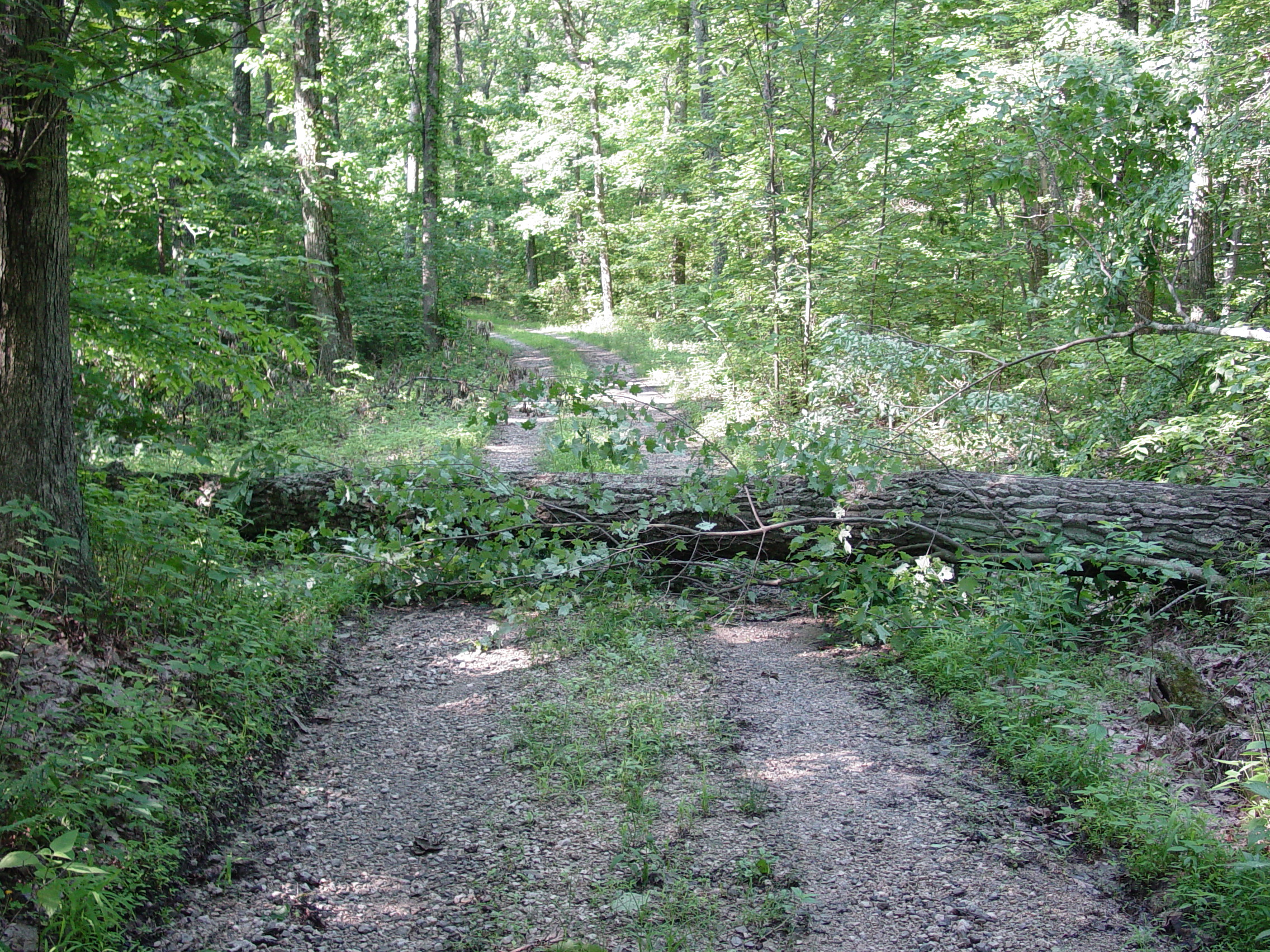 Don’t let roadblocks keep you from getting the most out of your property
Don’t let roadblocks keep you from getting the most out of your property
Survey procedures were the same as previous years. The survey was mailed to 216 firms, compared to 275 in 2012. Ten were returned as undeliverable. There was an initial mailing and one reminder postcard sent to non-respondents. Purdue’s Department of Forestry and Natural Resources pays for the assistance of the Indiana Office of USDA’s Agricultural Statistics Service using funds from its John S. Wright Endowment, not tax-based funds.
Forty-seven mills reported some useful data, compared to 52 in 2012, 56 in 2011, 62 in 2010, 73 in 2009 and 88 in 2008. Seventeen mills were dropped because their phones were disconnected, or they reported being out of business. The number of mills contributing price data for each product is shown in the second and third columns in Tables 1 and 2, and in the second column in Tables 3 and 4. Forty-three mills reported their 2012 board foot production, compared to 39 in 2011. Sixteen mills reported producing 1 million board feet (MMBF) or less. Fourteen mills reported production of 5 MMBF or greater. Total production reported was 151 MMBF compared to 134 MMBF in 2011, and 103 MMBF in 2010. The largest single mill production reported was 19 MMBF. These annual levels are not comparable since they do not represent a statistical estimate of total production.
Prices for most species had increased by the first of September. Log prices are directly tied to lumber prices since logs are delivered to mills on a continuing basis. This allows mills to base the price they pay on current lumber market prices. The connection to prices paid for standing timber is less direct, depending on how far in advance of logging a stand of timber is purchased.
Sawlog Prices
The number of mills reporting sawlog prices was up slightly again this year (Table 1). Almost without exception sawlog prices of the premium species were up significantly; changes of course varied by species.
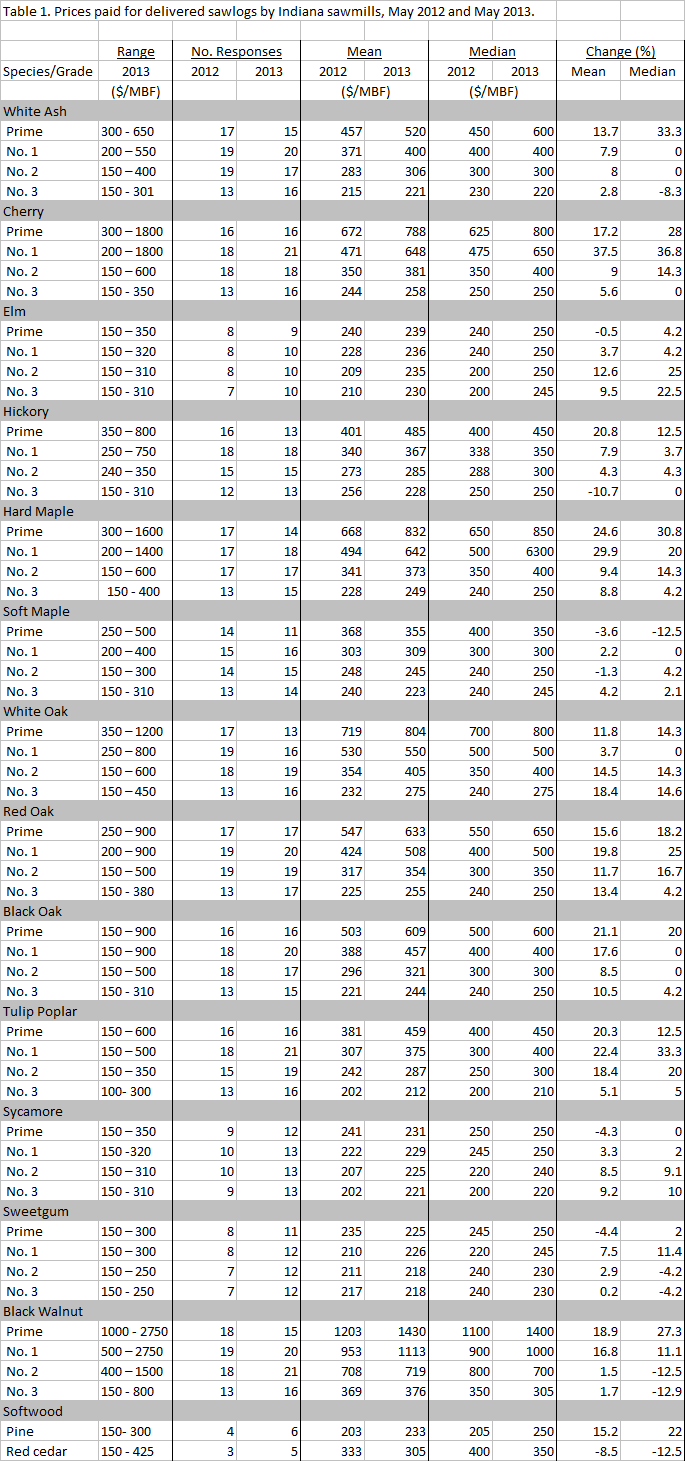
Selected Hardwood Species
All oak species were up significantly, generally in the 15 to 20 percent range.
All four grades of logs increased. Black oak prices were slightly below red oak’s, but many mills reported paying the same price for both species. It can be difficult to distinguish these two species of logs on a mill’s log deck. The lumber from these two and all other species in the red oak family is sold as simply red oak.
Increased demand for black walnut has caught mills and brokers with their inventories down. Production apparently hasn’t caught up with demand yet, so further price increases are likely for lumber and logs. Good markets increase the demand for good logs more than for the lower grades, thus increases of less than 2 percent for No. 2 and 3 logs. There are reports of men in new big white Cadillac’s prospecting the hinterlands for decent walnut timber. If the price cycles over the last 10 years are at all predictive, there is room for further price increases.
The increase in black cherry log prices was much greater than would be expected given steady lumber prices. However, in September the prices for the lower grades of lumber had increased slightly. Prices remain well below their peak in 2004.
Housing construction and rehab has pulled up the price of hard maple lumber and consequently the price of sawlogs. Prime logs were up almost 25 percent and No. 1’s almost 30 percent. This clearly indicates that mills are paying higher prices to get loggers to bring in this species. Hard and soft maple are not substitutes in finished goods markets, thus their prices can be expected to behave differently. Soft maple prices were essentially steady.
Although ash lumber prices have held steady for the last 24-month period, the average price of Prime logs was up 13.7 percent. This may be an indication that in parts of the state hard hit by EAB mortality, log supplies are tight. The average price for No. 1 and 2 logs was up about 8 percent.
Tulip poplar was up, over 20 percent for Prime and No. 1 logs. This is consistent with rising lumber prices. Foresters are concerned about the health of this species due to several years of dry weather. It grows best in bottoms and on north facing slopes. Drought will kill trees growing off-site. It’s hard to say whether this will mean more logs coming on the market. Extension Forester Lenny Farlee notes, however, that mortality occurs over several years as declining trees die slowly. The wood decays quickly making it necessary to harvest declining trees as soon as possible.
Softwood Logs
The price of pine sawlogs increased by $30 to $233 per MBF. Red cedar decreased by a similar amount. Compared to last year four more mills reported pine and cedar prices.
Veneer Log Prices
The number of mills reporting veneer log price was up substantially (Table 2). Prices were reported by both veneer mills and sawmills. Sawmills resell their inventory of veneer logs to veneer mills, exporters, and in some cases they saw these logs for specialty cuts like quarter and rift. The variation in prices would be reduced if only prices reported by veneer mills were used. Purdue Wood Products Professor Dan Cassens reports that there are only 16 face veneer plants still operating in the U.S. Plants that close can easily sell their equipment to firms in China. Thus, it will be necessary for this report to better reflect prices paid for logs being exported.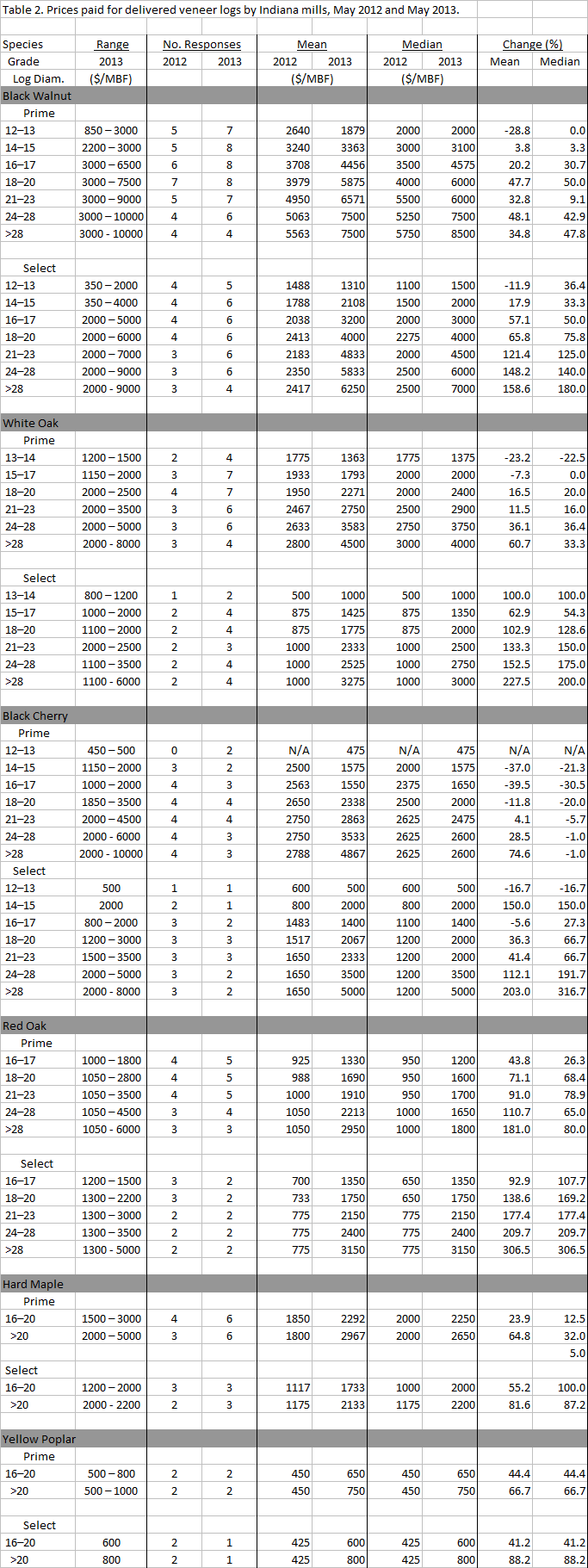
Veneer log prices were up broadly. When markets are strong mills can generally pay higher prices for larger and better quality logs. Likewise the reduced demand for the smaller and lower grade logs tends to drive down their price. This is the case for the average prices of smaller black walnut, white oak, and black cherry. Price reductions were greatest for black cherry. Except for black cherry the veneer log price increases were greater than the increase in the lumber prices of the same species. Both average and median prices increased because of the number of mills reporting large increases. Median prices change less than mean (average) price when price changes are smaller.
Miscellaneous Products
The prices paid for or received for various raw-wood products increased, Table 3. Pallet logs increased by $30 per MBF. These are lower quality and sometimes smaller logs purchased in batches of random species to be sawn or chipped into cants. The cants are re-sawn into boards used for pallets, blocking, railroad ties or other industrial applications. Some mills restrict purchases to specific species or exclude specific species, depending on the markets they sell to. The price per ton went up $1 per ton. 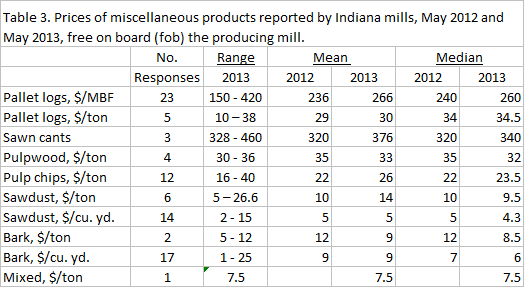
Custom Costs
Costs of custom services were generally down (Table 4). The two mills that reported an hourly charge for sawing logs into lumber indicated a large increase in the hourly rate. Logging costs as reported in this survey indicate a decrease in cost from $163 to $106 per MBF. This may be due in part to an increase in the number of active logging firms, relative to the three previous years when the poor economy drove many out of business.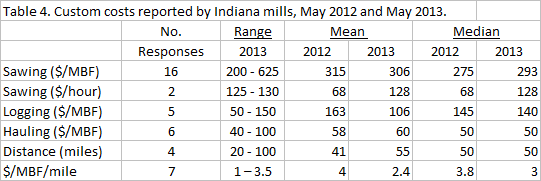
Indiana Timber Price Index
The delivered log prices collected in the Indiana Forest Products Price Survey are used to calculate the delivered log value of typical stands of timber. This provides trend-line information that can be used to monitor long-term prices for timber. The weights are based primarily on the 1967 Forest Survey of Indiana. Adjusting the weights for more recent forest surveys did not change the series enough to justify converting to a new series.
The nominal (not deflated) price is a weighted average of the delivered log prices reported in the price survey. The price indexes are the series of nominal prices divided by the price in 1957, the base year, multiplied by 100. Thus, the index is the percentage of the 1957 price. For example, the average price in 2013 for the average stand was 807.6 percent of the 1957 price. This year the index for a quality stand increased from 739.9 percent to 997.5 percent. This is the largest increase on record for this index.
The real prices are the nominal prices deflated by the producer price index for finished goods, with 1982 as the base year. The real price series represents the purchasing power of dollars based on a 1982 market basket of finished producer goods. It’s this real price trend that is important for evaluating long-term investments like timber and the log input cost of mills. Receiving a rate of return less than the inflation rate means that the timber owner is losing purchasing power, a negative real rate of return.
The price index used for the current year is the last one reported for the month when the analysis is conducted: July this year. The index increased from 194.2 for 2012 to 198.1 as of July 2013. Inflation in the 1 to 2 percent range is generally considered a sign of a healthy, growing economy. The change from 2012 to 2013 is about 2 percent.
The nominal weighted average price for a stand of average quality increased from $382.2 in 2012 to $449.1 this year. This is a 17.5 percent increase. This is just slightly below the peak of $452 in 2004. Remember that this series is based on delivered log prices, not stumpage prices. The deflated, or real, price increased from $197.9 in 2012 to $226.7 this year, a 15.2 increase (Figure 1). 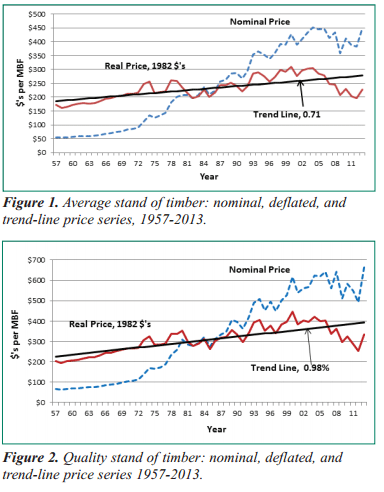
The nominal weighted average price for a high-quality stand increased from $492.70 in 2012 to $664.1 this year. This is a 34.8 percent increase, the largest on record. The average real price series for a high-quality stand increased from an adjusted $253.7 in 2012 to 335.3 this year. This is a 32.2 percent increase (Figure 2).
Implications
The extent to which holding a stand of timber increases purchasing power depends on when you take ownership and when you liquidate. The 57 year period used in this analysis is much longer than the typical length of ownership. This year’s increase in average value bodes well for the future if these prices hold up. The rate of increase in the trend line doesn’t include the return resulting from increase in volume per acre by physical growth, nor the potential increase in unit price as trees get larger in diameter and increase in quality. Maximizing these increases in value requires timber management.
William L. Hoover, Professor of Forestry, Department of Forestry and Natural Resources, Purdue University; Greg Matli, Deputy Director, Indiana Agricultural Statistics Service; and Duane McCoy, LTB Forester, Indiana Department of Natural Resources, Division of Forestry.
